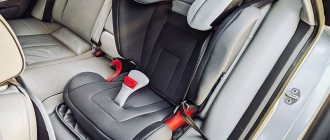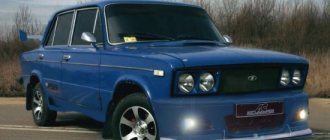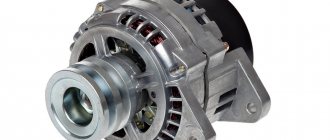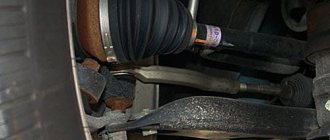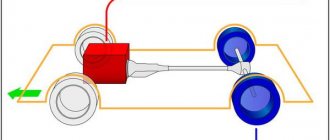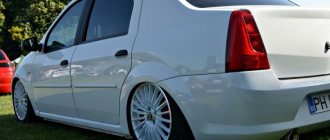Good afternoon, dear readers. As many of you have probably already guessed, today I want to talk about types of car bodies.
I remember times when hearing the word hatchback caused me bewilderment. I think that among the readers there will be people with a similar problem. In this article I will try to solve this problem.
In order not to mislead you, I explain that the picture on the left does not show a hatchback, but a dump truck . Yes, you probably guessed it yourself.
Now, in more detail directly about the bodies of passenger cars . The most common and popular body styles include: sedan, hatchback and station wagon. There are other types of bodies, such as coupe, convertible, limousine, and carriage. They are less popular today.
Hatchback
This body type is more modern than classic. In my opinion, now hatchback cars are gradually replacing classic sedans. And there is a reason for this. While the hatchback is generally shorter in length (the hatchback has a shorter rear overhang) than the sedan, the former has significantly more capacity.
The hatchback in different versions can have 3 or 5 doors. A 3-door hatchback is not a gift for a large family. In a car like this, sitting in the back seat is not fun.
History of creation
The hatchback is a fairly popular body type these days, which has long been a serious competitor to the sedan. The word “hatchback” is formed from two English words “hatch” - hatch and “back” - rear. The body began its history in the pre-war years. In the distant 40s of the twentieth century, the first cars with a wide rear hatch began to be produced by Citroen, and later the American company picked up the baton, releasing two models into the world: Frazer Vagabond and Kaiser Traveler. Hatchbacks gained wide popularity thanks to the efforts of the Japanese. In Europe, the fashion for these bodies began after the release of the French Renault 16.
Station wagon
Cars with this body type have increased capacity. Just like the hatchback station wagon, it has 5 doors. But the length of the station wagon is much longer. Typically, the rear door of a station wagon is located almost perpendicular to the ground. The rear seats of the station wagon can be folded and this allows you to significantly increase the luggage compartment (you can carry a small bull).
The station wagon, thanks to its capacity, is ideally suited for a large family. But the dimensions of such a car can cause inconvenience when driving in city traffic.
I wanted to finish the article, but I remembered another very common body type. Of course, this is a jeep .
Modern hatchback
We can say that from the very first appearance of the hatchback, everyone loved it. This happened, most likely, because it is superior to a sedan in almost everything, and it looks prettier... Of course, a lot of time has passed since the appearance of the first hatchback and today there are a huge number of body variations on the market: fastback (the shape of the body is similar to a teardrop), nightback, comeback, liftback. Even though cars such as crossovers are gaining popularity today, the hatchback holds its position with dignity.
Toyota Aqua
It is thanks to the short rear overhang that hatchbacks are very popular among female drivers; the short trunk helps both in city driving and when parking. This type of body can undoubtedly be considered family-friendly - there is plenty of space in the trunk.
Ford Focus
In addition, the hatchback's aerodynamic characteristics are in many ways superior to the sedan and station wagon. It is not for nothing that most popular auto concerns choose the hatchback body to create a sports version of the car.
Honda Civic Hatchback
Subscribe to our YandexZen
2 135
Crossover (SUV)
Crossovers (or jeeps) are cross-country vehicles. They are larger than other passenger cars and are more comfortable to drive. Crossovers may have a trunk or a fifth door, i.e. There are jeep station wagon, jeep hatchback and jeep sedan.
Today, a crossover is a fairly common phenomenon and is used not only for off-road driving, but also for comfortable spending time in city traffic jams.
Each driver chooses the body type according to his own needs. Historically, sedan cars have been the most popular in Russia, but over the past few years they have been gradually replaced by crossovers.
What type of car body do you prefer?
Is it better to choose a hatchback or a sedan?
To make it easier for you to decide on the body of your future car, we provide a list of the advantages and disadvantages of the sedan and hatchback. After reading it, you will receive useful information that will help you with your choice. Hatchback. Advantages
- Quite compact in size, but not burdened with a “tail,” which allows them to maneuver perfectly on city streets.
- Wide luggage compartment opening, which allows you to load large items (TVs, washing machines, etc.)
- Attractive appearance, somewhat similar to sports cars (in demand among young people).
Hatchbacks also have several disadvantages
- The absence of a partition and sound insulation between the passenger compartment and the luggage compartment leads to the fact that while driving you will hear and feel all the sounds and smells that come from the trunk.
- Also, due to the fact that the interior volume increases due to the trunk, warming up the car is difficult in winter.
- The size of the trunk becomes larger than the trunk of a sedan only if the rear row of seats is removed or folded.
Sedan. Advantages
- The sedan has a more presentable appearance than the hatchback. This makes it a favorite among older car enthusiasts.
- Insulated trunk. A feature that is a disadvantage in a competitor is absent in the sedan. You will not hear any extraneous noise from the trunk while driving.
Among the shortcomings we note:
- The most unpleasant drawback for sedans is the small trunk, as well as the small amount of space in the cabin.
- Compared to hatchbacks, sedans are larger, which makes driving in city traffic more difficult.
Hatchback and station wagon. What is the difference? If you analyze these two bodies, you can note several differences:
- Price.
As corny as it sounds, it’s true. Station wagons are much more expensive than hatchbacks. - Luggage compartment size.
Station wagons have noticeably more luggage space than hatchbacks. - Design.
The elegant shapes of hatchbacks look much more attractive than the strict lines of a station wagon.
It's time to sum it up. Hatchbacks are great cars for a small family. They combine comfort, practicality and attractive design. The hatchback is ideal for trips into nature; all the things you need on vacation will fit in its trunk. And within the city, the maneuverability and small size of this car will help you overcome traffic jams faster. Are you dreaming of a hatchback? Go to the catalog of passenger cars, which will help you navigate the prices. Popular hatchbacks that deserve your attention
• KIA Сee'd, a bestseller originally from Korea. Reliable and practical, with a long list of options and everything you'd expect from a modern C-Class car.
• Renault Sandero, an affordable hatchback from the French brand. A nice city compact, with a spacious interior and a roomy trunk. It withstands the hardships of Russian roads and weather.
• Ford Focus hatchback, an example of price-to-equipment ratio. Consistently high build quality, steering wheels and suspension tuned to our roads, reliable engines - all in favor of this model.
• Peugeot 308, the very embodiment of style. The latest generation of the model, both inside and outside, has become the most spectacular in the class. Pleasant to the touch materials and bold body lines make you fall in love with it.
Catalog of hatchbacks Catalog of sedans Ask a question
Characteristics
Comparison of a hatchback with a station wagon from the same model range
A distinguishing feature of the hatchback is the hatch-type hatchback's upward-opening rear door, which folds down at roof level (as opposed to the sedan/sedan's trunk/trunk lid, which folds down under the rear window). Most hatchbacks use a two-box body design, where the cargo area (trunk/trunk) and passenger areas are a single volume. The rear seats can often be folded down to increase the available cargo space. Hatchbacks may have a removable hard luggage rack or a flexible roll-up tonneau cover to cover the cargo area behind the rear seats.
Terminology 3 doors and 5 doors
When describing a body style, a hatchback is often considered a door, so a hatchback with two passenger doors is called a three-door.
and a hatchback with four passenger doors is
a five-door
.
Estates vs fastbacks vs notchbacks
Station wagons/station wagons and fastback hatchbacks share a two-box design, a common interior volume for passengers and cargo, and a tailgate (often called in the case of a station wagon/station wagon) that hinges on the roof. level.
The term "fastback" is sometimes used interchangeably with "hatchback", but this is incorrect because fastback
may also refer to a 4-door sedan with a separate trunk, such as the Tesla Model 3.
Some hatchbacks don't
are neither station wagon nor fastback, but notchback, such as the 1951 Kaiser-Frazer Vagabond and Simca 1100.
In a fastback, the rear of the car must have a single slope from the roof to the rear bumper; but this is not the case in the notchback hatchback.
A station wagon/station wagon is typically distinguished from a fastback hatchback by being longer (and therefore more likely to have a D-pillar). Other possible differences between the station wagon:
- steeper slope at the rear (i.e. the tailgate is more vertical)
- third row of seats
- rear suspension designed for increased load capacity or minimized cargo space intrusion
- the tailgate will most likely be in multiple parts or extend to the bumper
like a 4-door sedan
like a 5-door hatchback. The length of the rear overhang is the same as the other dimensions of the car.
In Europe, the term "hatchback" can mean a design with a profile similar to a sedan, although the length of the third box (rear) varies. It may be non-existent (), very short or vestigial ( liftback
1985 Toyota Celica) or long enough to be confused with the regular sedan body that may be offered with it (, , many others). While many such cars today have smooth, curved lines that make it difficult to tell where one "box" ends and another begins, the same applies to fastback sedans, making it difficult to distinguish the two at first glance body style.
Hatchback as a body style
When a car's body style is described as a hatchback, what is usually meant is a utilitarian small car (especially in the US).
Lift back
Liftback is a marketing term for hatchback models in which the rear cargo door or hatch has a more horizontal angle than the average hatchback, resulting in the hatch being raised more up than back to open.
1976 Toyota Celica GT Liftback US Model
The term was first used by Toyota in 1973 to describe the Toyota Celica Liftback GT.
Later in Europe, Toyota had to differentiate between two 5-door versions of the Corolla E90, one of which was a conventional 5-door hatchback with a nearly vertical rear hatch, and the other a more horizontal 5-door hatchback for which the term Liftback
.
What does a hatchback body type look like and how does it differ from other car modifications?
A hatchback is a body type characterized by the presence of a rear door, as well as a two or four-seater interior with a reduced rear overhang. The main advantage of the presented passenger car model over a sedan is the presence of a 5th door. This design significantly affected the load capacity and dimensions. A station wagon with a short body should not be confused with a liftback, which has a shorter rear overhang, but this part has a stepped shape. Don't overlook the debate surrounding the fastback, which is shaped like a hatchback but features a sleek rear end.
This is interesting: How to change pistons on a Priora
Separating a hatchback body type from another is not difficult. The design features of the machine provide for the presence of two compartments. If we are talking about the trunk, then it is separated using only the back of the sofa. With this design, the rear seats are transformed, and therefore the luggage capacity increases significantly.
Body type liftback
The liftback should be classified as a type of hatchback: the trunk lid is also combined with the rear window and plays the role of a fifth door. However, external signs from the side are the reason that this type of body is often confused with a sedan, in which the rear protrusion resembles a luggage compartment.
There are varieties of hatchbacks in which the fifth door is vertical. This parameter makes the model look like a minivan, but its height is significantly greater. The improved aerodynamics of the liftback, handling and low weight attract many modern automakers. Therefore, they create high-speed vehicle models based on the presented design.
Favorites among hatchbacks and liftbacks: ranking of the best
This class of cars is relatively young, but has already managed to firmly establish itself in the model range of many manufacturers. Below is a rating of hatchbacks based on the assessment of car owners.
So, TOP 20 models that car enthusiasts are satisfied with:
- Audi A5;
- Audi A7;
- Honda Civic Type R;
- Porsche Panamera;
- Opel Insignia;
- Skoda Superb
- Subaru Impreza WRX STI;
- Audi S5;
- Toyota Aqua;
- Lexus CT200h;
- Hyundai Veloster;
- Audi A1;
- Honda Accord;
- Honda Crosstour;
- Honda Free Spike;
- Nissan Leaf;
- BMW 5-Series Gran Turismo;
- Citroen DS4;
- Volvo C30;
- Mini Hatch.
A hatchback is an increased level of safety, original design, ease of use and aesthetic appeal, which is why the body type is so popular in a modern city for performing everyday tasks.


